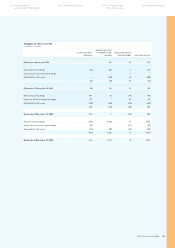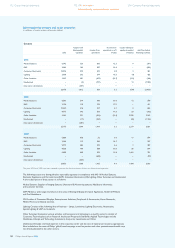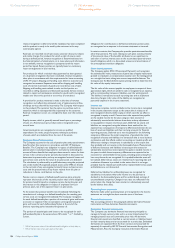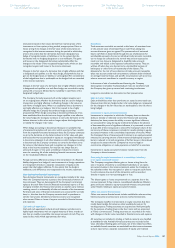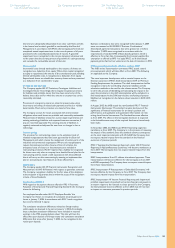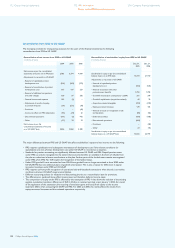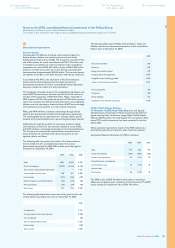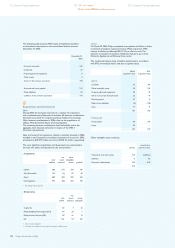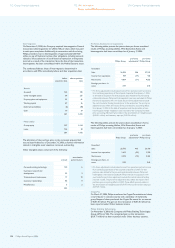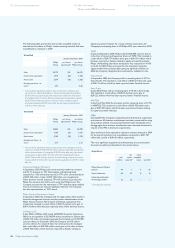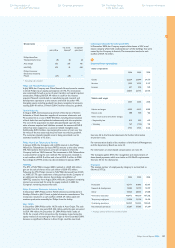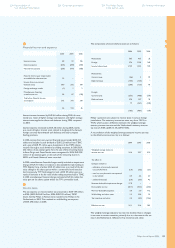Philips 2006 Annual Report Download - page 189
Download and view the complete annual report
Please find page 189 of the 2006 Philips annual report below. You can navigate through the pages in the report by either clicking on the pages listed below, or by using the keyword search tool below to find specific information within the annual report.
Philips Annual Report 2006 189
this level are substantially independent from other cash fl ows and this
is the lowest level at which goodwill is monitored by the Board of
Management. In accordance with IFRS 3, the Company performed and
completed annual impairment tests in the second quarter of all years
presented in the consolidated statements of income. A goodwill
impairment loss is recognized in the income statement whenever and
to the extent that the carrying amount of goodwill of a cash-generating
unit exceeds the recoverable amount of that unit.
Share capital
Incremental costs directly attributable to the issuance of shares are
recognized as a deduction from equity. When share capital recognized
as equity is repurchased, the amount of the consideration paid, including
directly attributable costs, is recognized as a deduction from equity.
Repurchased shares are classifi ed as treasury shares and are presented
as a deduction from stockholders’ equity.
Provisions and accruals
The Company applies IAS 37 ‘Provisions, Contingent Liabilities and
Contingent Assets’. Accordingly, the Company recognizes provisions
for liabilities and probable losses that have been incurred as of the
balance sheet date and for which the amount is uncertain but can be
reasonably estimated.
Provisions of a long-term nature are stated at present value when
the amount and timing of related cash payments are fi xed or reliably
determinable. Short-term provisions are stated at face value.
The Company accrues for losses associated with environmental
obligations when such losses are probable and reasonably estimatable.
Measurement of liabilities is based on current legal requirements and
existing technology. Liabilities and expected insurance recoveries, if
any, are recorded separately. The carrying amount of liabilities is
regularly reviewed and adjusted for new facts or changes in law or
technology.
Restructuring
The provision for restructuring relates to the estimated costs of
initiated reorganizations that have been approved by the Board of
Management, and which involve the realignment of certain parts of the
industrial and commercial organization. When such reorganizations
require discontinuance and/or closure of lines of activities, the
anticipated costs of closure or discontinuance are included in
restructuring provisions. IAS 37 requires that a liability be recognized
for those costs only when a company has a detailed formal plan for the
restructuring and has raised a valid expectation with those affected
that it will carry out the restructuring by starting to implement that
plan or announcing its main features to those affected by it.
Guarantees
The Company applies IAS 39 ‘Financial instruments: Recognition and
Measurement’ and IAS 18 ‘Revenue’ with respect to guarantee contracts.
The Company recognizes a liability for the fair value of the obligation
at the inception of a guarantee that is within the scope of the recognition
criteria of these Standards.
Application of IFRS 1
With regard to the options that are offered in IFRS 1 ‘First-time
Adoption of International Financial Reporting Standards’ the Company
chose the following:
For employee benefi ts under IAS 19 ‘Employee Benefi ts’ the
Company has chosen to recognize all cumulative actuarial gains and
losses at January 1, 2004. In accordance with IFRS 1 such recognition
has occurred directly in equity.
The cumulative translation differences related to foreign entities
within equity are deemed to be zero at January 1, 2004. Accordingly,
these cumulative translation differences were included in retained
earnings in the IFRS opening balance sheet. This also will have the
effect that upon disposal of a foreign entity only cumulative translation
differences that arose after January 1, 2004 can be recognized in the
result upon disposal.
Business combinations that were recognized before January 1, 2004
were not restated to IAS 22/IFRS 3 ‘Business Combinations’.
Share-based payment transactions that were granted on or before
November 7, 2002 were recognized in accordance with the
requirements of standard IFRS 2 ‘Share-based payments’, which is
effective as from that date. Consequently, the Company applied the
exemption as offered by IRFS 1 to apply IFRS 2 to all share-based
payment grants that had not vested as at the date of transition to IFRS.
IFRS accounting standards effective as from 2007
The IASB and its interpretation committee IFRIC issued several
pronouncements which will take effect as from 2007. The following
are applicable to the Company.
The most important development with a material impact on the
fi nancial outcomes is IFRIC’s draft interpretation D19 on Minimum
Funding Requirements for pensions. The draft interpretation clarifi es
recognition criteria for overfunding of pension liabilities and the
calculation methods to be used for the relevant assets. The Company
is still in the process of identifying and calculating the impact in the
event the provisions in the draft interpretation will be included in a
fi nal
interpretation. At the 2006 year-end, the overfunding of pension
liabilities
not recognized on the balance sheet amounts to EUR 2,235
million.
In August 2005, the IASB issued the new Standard IFRS 7 ‘Financial
Instruments: Disclosures’. The standard requires disclosure of the
signifi cance of fi nancial instruments for an entity’s position and
performance, and qualitative and quantitative information on risks
arising from fi nancial instruments. The Standard becomes effective
as from 2007. The effect on the Company’s disclosure is expected
to be limited because many of the required disclosures have already
been made.
In November 2006, the IASB issued IFRS 8 ‘Operating segments’,
mandatory as from 2009. The Company is in the process of reviewing
the impact of this standard. Since this standard achieves convergence
on the most important elements with US GAAP, the Company does
not expect material impact from this standard on the fi nancial
outcomes of previous periods.
IFRIC 7 ‘Applying the Restatement Approach under IAS 29 Financial
Reporting in Hyperinfl ationary Economies’ will become mandatory as
from 2007. The Company does not expect material impact from this
interpretation.
IFRIC Interpretations 8 and 11 address share-based payments. These
interpretations will become effective for the Company as from 2007
and 2008 respectively. The Company does not expect material impact
from these interpretations.
IFRIC Interpretation 9 ‘Reassessment of Embedded Derivatives’ will
become effective for the Company as from 2007. The Company does
not expect material impact from this interpretation.
IFRIC Interpretation 10 ‘Interim Financial Reporting and Impairment’
prohibits impairments of goodwill and certain fi nancial instruments in
an interim report to be reversed in a later period. For the Company,
the interpretation becomes effective as from 2007, but will not have
an impact on outcomes presented in previous periods.
226 Corporate governance224 Reconciliation of
non-US GAAP information
234 The Philips Group
in the last ten years
236 Investor information




